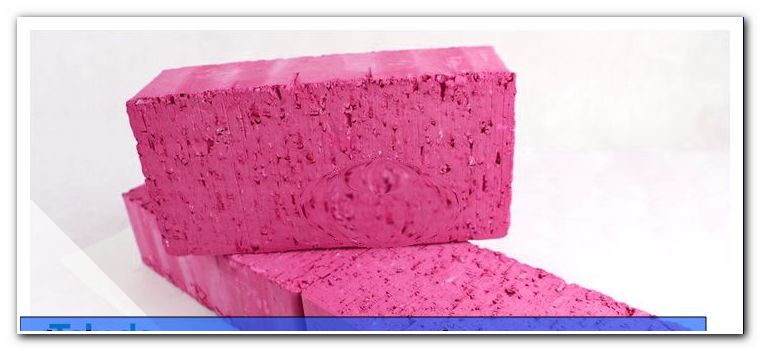Build wooden shelter - firewood shelter in 5 steps

- Material and preparation
- Instructions: Build firewood shelter
- Step 1 - Foundation / Base
- Step 2 - Floor of the shelter
- Step 3 - Upright Stand
- Step 5 - Construct the roof
- Step 5 - sides and back wall
Many homeowners today rely on the coziness of a stove. In addition to the homelike atmosphere, the stove also offers enormous savings in heating costs. But especially important is a dry, yet airy storage of the wood. We would like to show you how to build a practical wooden shelter yourself.
While the cost of heating continues to rise, so does the cost of a new stainless steel chimney. The stoves for the living room are sometimes very cheap. The ovens even look good in the living rooms. So you kill two birds with one stone with a stove. However, there is a catch, because storage space is scarce nowadays and the wood has to be stored dry and airy for two years in a covered area. The supply for two years takes up a lot of space. Therefore, we show in the guide a firewood shelter, which you can adjust in size to your needs.

Material and preparation
You need this material (depending on the construction):
- spade
- wheelbarrow
- spirit level
- saw
- drilling machine
- combination wrench
- Ratchet and bits
- hammer
- screwdriver
- guide
- sledgehammer
- Squares
- brush
- ruler
- pencil
- Beams / posts
- battens
- boards
- Gravel / gravel
- Grass pavers
- Ground sleeves / point foundation
- angle connector
- Corrugated cardboard / roofing
- Schauben
- bolt
- nails
- rain barrel
- thin chain
- Wood preservation glaze
Reason for a firewood shelter - dry wood
So that your chimney sweep picks up the firing place, he not only looks closely at the stove and the chimney, but also from time to time your stock of wood. He checks if you really only burn pure wood and not some chipboard or coated and painted wood. In addition, the chimney sweep checks the residual moisture in the wood with a small measuring device. The residual moisture should be no more than 20 percent, so you can burn the wood clean.

Tip: Create a small measuring device with which you can check the residual moisture in the wood itself. These devices are only slightly larger than a lighter and tell you if necessary, the residual moisture in a wall. From about ten euros you will find such residual moisture meters in every hardware store.
Orientation of the shelter and design
In order for the wood to dry properly and reach the permissible residual moisture, it is important that it is not stored in a closed shed, but in a partially open firewood shelter. Therefore, the sides of the shelter should not be completely closed. In Germany the weather usually comes from the west. That's why the slightly lowered roof with the gutter should be placed on this side. To prevent constant moisture due to driving rain. A southeast orientation of the open side would be ideal. When the sun moves from east to west during the day, the wood becomes dry and combustible relatively quickly.
Costs and prices for the materials ">
 There are ready made kits in the trade for your fireplace shelter. But the low-cost kits rely on rather inferior wood. The high-quality wood deposits are priced quite high, then the savings by the firewood for many years is already used up. It is cheaper if you build the fireplace wood shelter yourself and plan. So you can adjust the size optimally to your needs and the amount of wood. The roof panels can then be color-matched to the roofing of the house. Thus, the shelter is a round thing, which also gives a lot of visual pleasure.
There are ready made kits in the trade for your fireplace shelter. But the low-cost kits rely on rather inferior wood. The high-quality wood deposits are priced quite high, then the savings by the firewood for many years is already used up. It is cheaper if you build the fireplace wood shelter yourself and plan. So you can adjust the size optimally to your needs and the amount of wood. The roof panels can then be color-matched to the roofing of the house. Thus, the shelter is a round thing, which also gives a lot of visual pleasure.
Here are some sample prices for different materials:
- Ground sleeves / wrapping pieces, depending on size between 2 and 5 euros
- alternatively ground sleeves for screwing in 4 pieces about 70 euros
- vertical stand planed and impregnated 240 x 9 x 9 cm - from about 10 euros
- horizontal beams / slats 240 x 7 x 3.5 cm - pieces from 2.50 euros
- Planks for sides and back wall - 300 x 10 x 2 cm - piece about 2.50 euros
- asbestos-free corrugated sheets 92 x 160 cm - about 20 euros
Tip: Just do a regional search for a sawmill. Often there is the wood there much cheaper than in the hardware store. A search on the Internet, for example. For the impact sleeves, worth a higher number of pieces.
Consider alternative material
You should also think about which wood you want to use. Do you want planed boards, these are of course a bit more expensive. Or if you want to build a natural-looking shelter, then you should inform yourself about the so-called western fence. This consists of rafter boards (untreated) and has its own charm, which remains even after many years. Big advantage the boards do not have to be glazed or otherwise treated by their nature optics (but can).
Pallets - favorable shelter
A particularly favorable alternative are pallets for the floor and side walls of the shelter. If you have a chance to get used pallets from a freight forwarder that cost little or nothing, you'll almost have a large portion of your shelter ready.
Optimal is also the draft that pulls through the boards of the pallets and dries the wood. In addition, you need much less stable wood for the construction of pallets because the pallets themselves already provide stability.
Wood stack holder - hardware store
At the hardware store, there are practical wooden stacking racks in which slats are simply inserted. As practical as these stacking aids may be, they are not suitable for permanent use. After all, you still need a canopy to keep out the rain. This is usually difficult to realize with these stacking aids. If the stacks of wood in these brackets are badly packed, they also fall over in strong winds like. So these wooden stacking holders are only something for an intermediate shelf directly on the wall of the house, which absorbs only just in the short term the amount of wood needed.
Instructions: Build firewood shelter
You can plan the size of the firewood shelter relatively freely yourself. Note, however, that a very wide shelter may require another post in the middle. If you have already selected a roofing, you should resize the shelter to fit the available board sizes. It would be a shame if you had to buy another roof tile because of 20 centimeters. Do not forget about the required overlap of the plates in these calculations. However, if you lay out a wooden roof with boards, this does not matter.
Also, when planning the size, keep in mind which surface you want to use. If you plan to stack the wood on pallets, keep in mind that there are also different sizes here. - Please inform in advance where you can get the Holpalettes and what dimensions they have. If you use a substrate made of gravel and grass pavers, this is irrelevant.

Tip: If you want to accommodate wood for several years, you should either build multiple shelters, or divide the new shelter into different areas. Otherwise you would always have to clear the still wet wood and vice versa. It is not just the inventories of different lengths that are mixed up, it would also be a lot of work and a constant nuisance when fetching wood.
Step 1 - Foundation / Base
Depending on the size of your wood shelter, it is often sufficient to hammer in bottom sleeper sleeves for the four or more upright posts of your shelter. To do this, you first use four wooden pegs or iron bars, which you align in your garden. Then check with a guide whether the pegs are in line.

Tip: If you build a larger shelter, you can even make practical point foundations. For this you need an old bucket and a beam shoe per point foundation. The bucket is then filled with a cement mixture and the beam shoe is pressed into it. After drying, these dot foundations are buried just like ready-bought concrete foundation points.
Then you can hit the ground impact sleeves in the ground at the place of the pegs. This is achieved with a short piece of post, which is adapted in length to your body size. This is placed on the ground socket and hit with the sledgehammer in the ground. Be careful not to knock the sleeves too deeply, as the wood of the posts may not come into contact with the wet floor later. In between, check whether your pods are straight by either applying a plumb line and / or applying the spirit level.
Step 2 - Floor of the shelter
For the underground you have several options:
- Gravel layer and grass pavers
- Bricks and pallets
Version 1:
So that the soil under the wood is later completely dry, a gravel layer is needed. To do this, lift the ground about 20 centimeters deep and fill the hole with coarse gravel or gravel up to the top.
To cover the area even better, grass pavers are a good choice. But this time they will not just be laid with the soil, but above it. In this case, you should not fill the holes of the stones with gravel, but simply leave empty. So the wood is never in the damp soil and can also dry from below something.

Variant 2:
Flatten the earth for the underground. Then you can place bricks on top of which you can put pallets on which the wood is stored. An advantage of this variant is that the wood is also well ventilated from below. The pallets are more robust than you might think and extremely cheap.
Tip: Many do-it-yourselfers first put on the floor of the shelter and then hit the sleeves first. Which order you prefer is up to you. We only have to consider that in case of doubt you will have to pound the pods through a thick layer of gravel, which is not easy to realize.
Step 3 - Upright Stand
The posts are placed in the point foundations or wrapping sleeves and bolted. So that the wood is not split, it makes sense to pre-drill the holes. Align the posts absolutely vertically with a spirit level. So you do not have to set up at each post somebody who holds the posts, you should install a board of the side and rear wall paneling approximately in the middle already.
Tip: You do not have to be afraid that the distribution of the boards may not work out later, because there must be a larger gap in the side wall anyway due to the air circulation at the top and bottom. Be sure to work with the spirit level and drill out the holes.
If your wooden shelter is to be deeper than about 80 centimeters, it is necessary to plan the slope already at the erection of the posts. The two front posts should then be slightly higher. All four posts must be bevelled backwards accordingly.

For larger shelters, it is recommended to stabilize individual beams by means of a metal strip.
Step 5 - Construct the roof
On the front side, the roof must be raised slightly, so that a sufficiently large slope is created. The simple solution to this is to double. The crossbar at the front is placed either double or simply upright. Since a wooden shelter usually does not have a great depth, this form of attachment is not problematic and the roof panels can not sag over the short distance.
The roof of the wooden shelter should not only be tight, it is also important that it fits the environment. If you use shingles, they should be the same color as your rooftop. Plates are easier to install and last longer than plain tar paper.

Under the tar paper, a full-surface wooden structure must be attached. Which is a bit more expensive. If the tar paper gets leaky over time, moisture quickly gets into these wood panels, which cause rotting. Therefore, bitumen welding membranes can be used for sealing.
However, if your firewood shelter gets deeper, you should prepare the lath construction for the roof on the ground. This construction is then mounted with the angle connectors on the bevelled posts. Check back and forth with the spirit level, if your roof construction is in the balance. Then the roof panels with the appropriate overlap are applied to the construction. Use the appropriate cap screws so that water does not run into the structure later on.
gutter
So that the floor around the wooden shelter does not float after every downpour and soaks your precious wood, you should install a small gutter on the roofing. Lead the water away from your wood supply as much as possible. The ideal solution is a rain barrel, which you set up on a gravel base about two meters away from the pile of wood.

Tip: If you buy the rain gutter just too long, it can protrude directly to the rain barrel. At the end then a light chain or a thick string of plastic fabric is attached. So the water runs very clean and without large splashes in the rain barrel. In addition, you always have soft rainwater for your plants.
Step 5 - sides and back wall

Between the wall boards about half the board width should remain free. If you want to install boards both inside and outside, make sure that these are screwed offset. If you want a very exact division with equal distances, you should first mark the boards on the post. Work a lot with the spirit level, so that the later impression becomes straight and even.
Tip: Instead of the boards, you can use fence elements for the side and rear walls. Especially if you have also installed the same fence elements in your garden, this solution creates a harmonious overall picture. However, when planning the shelter you will have to think about the available widths of these elements.
Do not forget to let the wood in once again with wood preservation glaze after completion. Even impregnated wood needs an extra protective coating outdoors. With a glaze you can also customize the color of the wood to your wishes.
Tips for quick readers
- Put soil pods / point foundations in the ground
- Prepare / pave floor area
- Set up and align the posts
- Adjust and assemble cross struts
- Fit slats for roof construction
- Mount roof panels / sufficient overlap
- Align the rear wall boards with the spirit level
- Distances between the boards regularly
- Attach side boards - keep the distance evenly
- Always use the spirit level again
- instead of boards also fence elements possible
- Attach the gutter to the rear roof overhang
- ensure water drainage in rain barrel
- Protect wood regularly against weather




